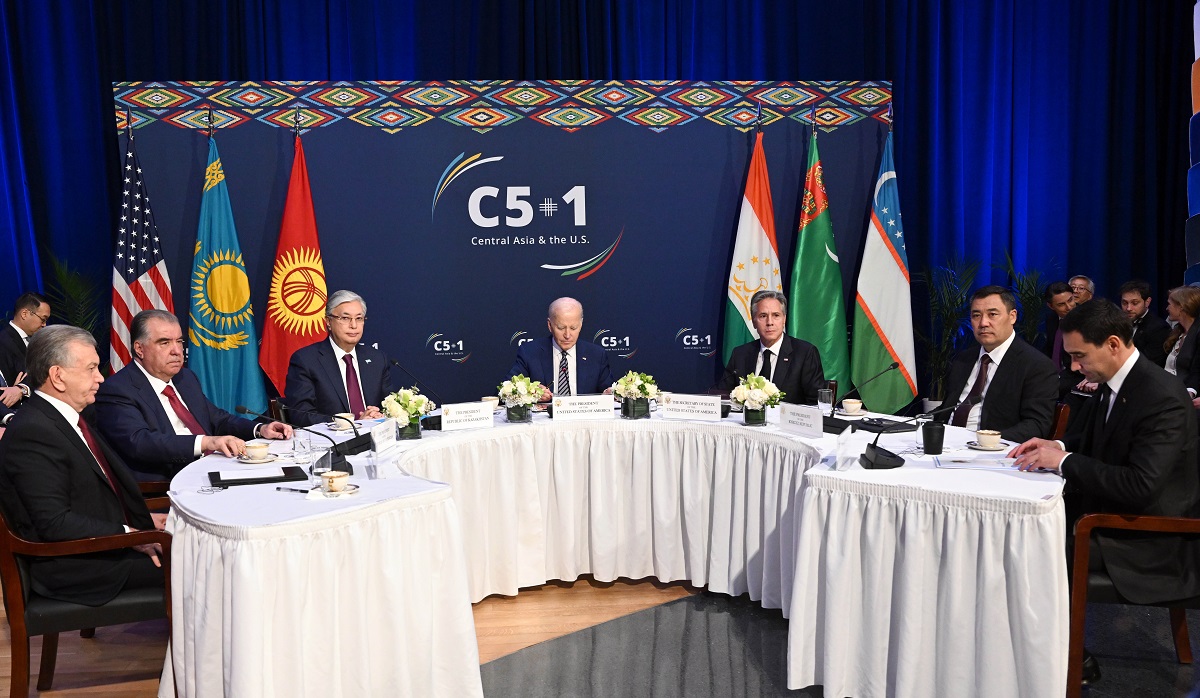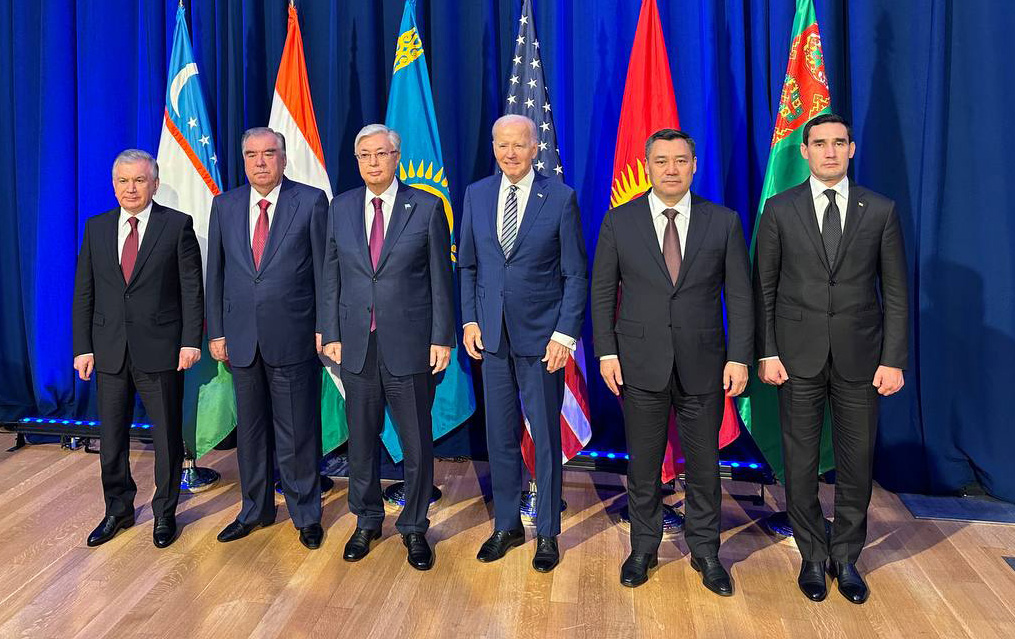It became obvious, according to political analysts, after the summit of Central Asian presidents and the U.S. president, which was held on September 19 in New York during the UN General Assembly.
This is the so-called C5+1 platform designed to deepen collaboration between the five regional countries and the United States. It has been functioning since 2015 at the level of ministers in charge of economy, security, environment, etc.
This meeting was held for the first time at the presidential level.

According to Kyrgyzstan-based political analyst Emil Dzhuraev, the summit does not enshrine any expectations regarding the change of geopolitical balance initially, yet shows great interest of the United States to the region.
“Heads of Central Asian states and other parties have admitted that the United States pay more attention to the region than it used to be after the US withdrawal from Afghanistan. But it remains to be seen what will come next and what serious steps the U.S. can take and which relationships it can build,” Dzhuraev said.
However, Rustam Burnashev, professor of Kazakhstan-Germany University, feels more sceptical about it. According to him, the summit is solely symbolic because it allows all countries in the region to show their multi-vector policies once again, and on the other part, to declare Central Asia as a “region”.
“As the summit showed, no decisions were taken on it. It all was limited to articulation of issues common for the discussion of the situation in Central Asia and around it. Moreover, it is obvious that the C5+1 format (with participation of any out-of-region power as +1) is a purely diplomatic and consultative format since all decisions are reached at the bilateral level only. The same was shown by summits in the Central Asia and Russia, Central Asia and China, Central Asia and European Union formats,” Burnashev said.
Prior to the summit, human rights activists urged President of the United States Joe Biden to pay attention to human rights violations in Central Asian states – increased pressures on journalists and activists, persecutions and torture.
“Biden must demand clear steps to put an end to politically motivated persecutions, repression of free speech and impunity for torture and police brutality,” said Iskra Kirova, advocacy director of HRW in Europe and Central Asia.
However, according to official messages, the national leaders sidestepped these questions.
Security issues
Regional security has become an important issue of the summit. All national leaders have noted the importance of peace and stability in Afghanistan.
According to Emomali Rakhmon, Tajikistan provides its logistical capacities, including six bridges along the border of Tajikistan and Afghanistan, to give humanitarian aid to the people of Afghanistan. Moreover, the republic supplies electricity to neighbours and exports construction materials and food via border markets.
By results of the meeting, Joe Biden noted that the United States and Central Asian states committed to continued collaboration on counterterrorism. It includes increased U.S. financial support to the region.
Taking into account the continuing war in Ukraine, there were some messages towards Russia during the meeting. According to the press service of U.S. President Joe Biden, the leaders emphasised “the need to respect the sovereignty and territorial integrity of all nations, and ongoing reforms to improve governance and the rule of law.”
According to political analyst Emil Dzhuraev, this message has a clear message towards Russia.
“It seemed to me that Biden wanted to tell all leaders of Central Asian nations that the United States saw a possible threat to security and territorial integrity, state security from unnamed countries. It was clear whom he meant,” the expert said.
There were no official messages about whether the leaders discussed the issue of compliance with anti-Russian sanctions by Central Asian states. However, according to experts, this issue was raised behind closed doors. Nevertheless, Parviz Mullodzhanov believes that compliance with sanctions is rather a conditionality.
“The United States need to reduce the flows of sanctioned goods to Russia. So, they meet with Central Asia, Southeast Asia and other regions. This rhetoric will remain, yet its intensity will reduce, and no sanctions will be imposed for any violations. The U.S. make everything to have Ukraine win and will close their eyes to some violations,” the expert said.
As to intraregional conflicts, for example, between Kyrgyzstan and Tajikistan, the United States should not be relied on, according to experts.
“I believe we do not need mediators in solving border issues, generally. We need to solve them by ourselves. And this is very important. Or, in case of urgency, we can resort to the mediation of such bodies as the UN,” said Chinara Esengul, political analyst and security expert.

Collaboration and prospects
According to Chinara Esengul, this meeting held at the level of leaders of states invited by Joe Biden shows that the United States want to come back to the Central Asian region strategically.
“Especially, in terms of economy. Because after withdrawal from Afghanistan in 2021, Americans have reduced all interactions with the region significantly,” she added.
In this sense, the United States are interested to balance the increasing influence of China in Central Asia. According to Tajikistan-based political analyst Parviz Mullodzhanov, as long as Russia is waging a war in Ukraine, the balance of power has been disrupted.
“The geopolitical balance in the region has been disrupted because Russia is too busy with the war in Ukraine and confrontation with the West, and dedicates all its efforts to it. This situation is unprofitable for Central Asian states,” he said.
And the United States can offer trade and investment agreements and development of business to the region, in the first place.
“The United States is home to most important technologies, most advanced companies that bring us to the next phase, stage of economic development, whether artificial intelligence or financial and technical innovations, etc. This is something that can and must arouse our interest, first of all,” Emil Dzhuraev said.
Regional countries are interested in economic collaboration. Heads of states reportedly raised a wide range of issues at the meeting: from food security to drug trade and situation in Afghanistan. President of Kyrgyzstan Sadyr Japarov noted that the country was ready for international collaboration in green economy, hydraulic power industry, IT, education and infrastructure projects. He added that Kyrgyzstan was going to further expand bilateral trade and economic relations with the United States.
“We stand for a wider presence of foreign partners, including American businesses, in our country and in the region,” Japarov said.
According to the administration of President of Kazakhstan Kasym-Zhomart Tokayev, special emphasis was placed on economic collaboration and opportunities for American companies in spheres of mineral exploitation, development of renewable energy sources, processing industry, etc.
Leaders of Tajikistan, Emomali Rakhmon, and Uzbekistan, Shavkat Mirziyoyev, also noted the importance of collaboration with the United States in various spheres.
“In terms of the urgent task of green economy promotion, Tajikistan pays primary attention to development of green energy,” Emomali Rakhmon said.
At the post-summit briefing, Biden said that leaders of states agreed to establish a new business platform to connect businesses in the United States and Central Asia for further collaboration. He also noted that they were discussing the potential for a new critical minerals dialogue between the United States and regional countries. Besides, the new initiative on disability rights will be launched in Central Asia.
According to experts, establishment of all these platforms shows once again that the United States want to be more economically active in Central Asia.
“Here they are trying to balance China in the region rather than Russia,” Esengul said.
According to her, competition for minerals is taking place because non-renewable resources become less available. Despite the focus on alternative sources of energy, traditional ones remain important because this is how the global energy system works.
She said that regional countries want more investments, strengthening of trade and economic relations with rich countries. In this sense, there are directions where China’s and States’ interests coincide, which gives the region the opportunity to collaborate with both parties.
“For example, the Trans-Caspian Corridor. Both the United States and China are interested in recovering this commercial infrastructure between the East and the West. Therefore, I don’t think their interests will differ here and Central Asia would suffer because their partners would demand different things,” Chinara Esengul said.

